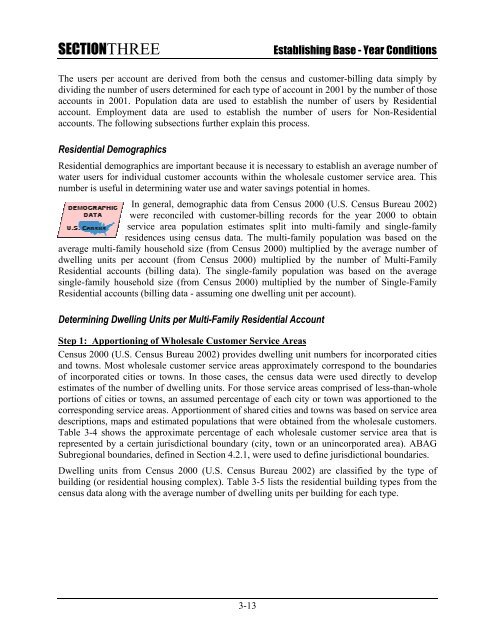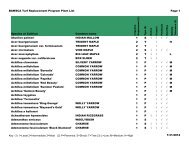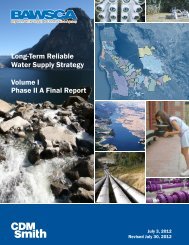SFPUC Wholesale Customer Water Demand Projections ... - BAWSCA
SFPUC Wholesale Customer Water Demand Projections ... - BAWSCA
SFPUC Wholesale Customer Water Demand Projections ... - BAWSCA
Create successful ePaper yourself
Turn your PDF publications into a flip-book with our unique Google optimized e-Paper software.
SECTIONTHREE<br />
Establishing Base - Year Conditions<br />
The users per account are derived from both the census and customer-billing data simply by<br />
dividing the number of users determined for each type of account in 2001 by the number of those<br />
accounts in 2001. Population data are used to establish the number of users by Residential<br />
account. Employment data are used to establish the number of users for Non-Residential<br />
accounts. The following subsections further explain this process.<br />
Residential Demographics<br />
Residential demographics are important because it is necessary to establish an average number of<br />
water users for individual customer accounts within the wholesale customer service area. This<br />
number is useful in determining water use and water savings potential in homes.<br />
In general, demographic data from Census 2000 (U.S. Census Bureau 2002)<br />
were reconciled with customer-billing records for the year 2000 to obtain<br />
service area population estimates split into multi-family and single-family<br />
residences using census data. The multi-family population was based on the<br />
average multi-family household size (from Census 2000) multiplied by the average number of<br />
dwelling units per account (from Census 2000) multiplied by the number of Multi-Family<br />
Residential accounts (billing data). The single-family population was based on the average<br />
single-family household size (from Census 2000) multiplied by the number of Single-Family<br />
Residential accounts (billing data - assuming one dwelling unit per account).<br />
Determining Dwelling Units per Multi-Family Residential Account<br />
Step 1: Apportioning of <strong>Wholesale</strong> <strong>Customer</strong> Service Areas<br />
Census 2000 (U.S. Census Bureau 2002) provides dwelling unit numbers for incorporated cities<br />
and towns. Most wholesale customer service areas approximately correspond to the boundaries<br />
of incorporated cities or towns. In those cases, the census data were used directly to develop<br />
estimates of the number of dwelling units. For those service areas comprised of less-than-whole<br />
portions of cities or towns, an assumed percentage of each city or town was apportioned to the<br />
corresponding service areas. Apportionment of shared cities and towns was based on service area<br />
descriptions, maps and estimated populations that were obtained from the wholesale customers.<br />
Table 3-4 shows the approximate percentage of each wholesale customer service area that is<br />
represented by a certain jurisdictional boundary (city, town or an unincorporated area). ABAG<br />
Subregional boundaries, defined in Section 4.2.1, were used to define jurisdictional boundaries.<br />
Dwelling units from Census 2000 (U.S. Census Bureau 2002) are classified by the type of<br />
building (or residential housing complex). Table 3-5 lists the residential building types from the<br />
census data along with the average number of dwelling units per building for each type.<br />
3-13







